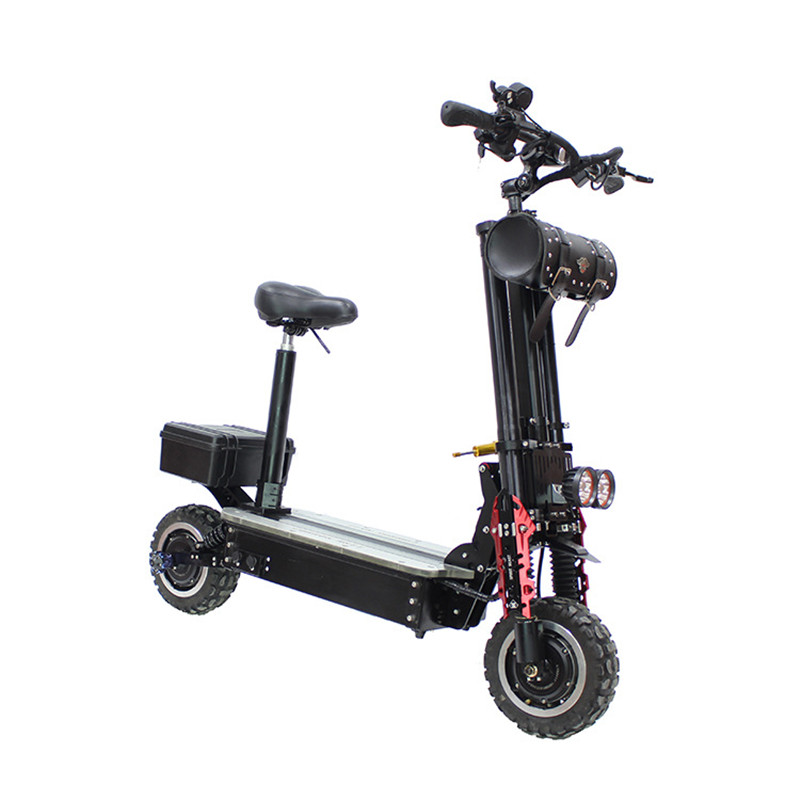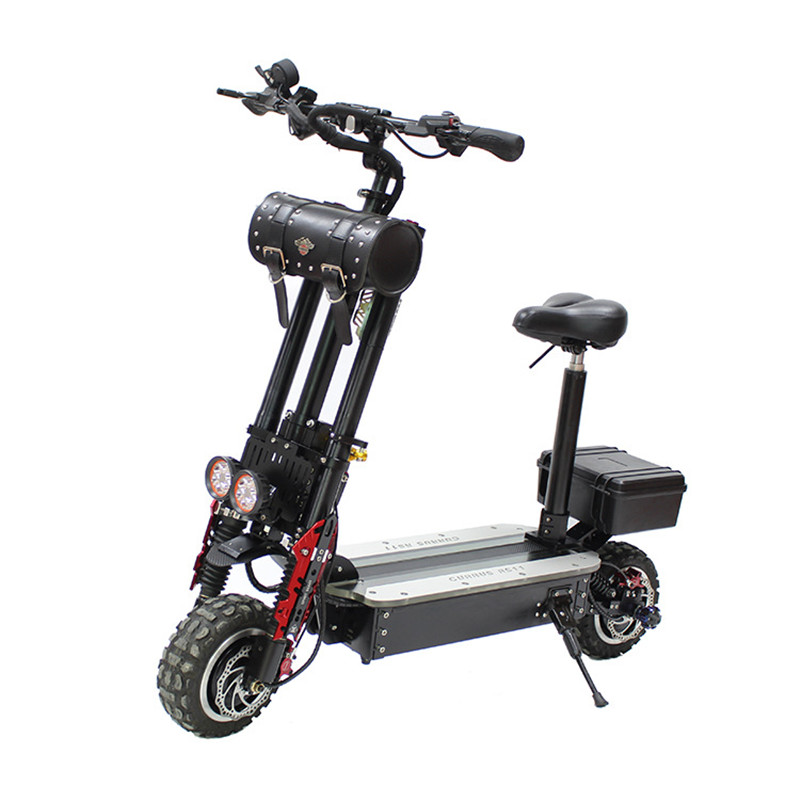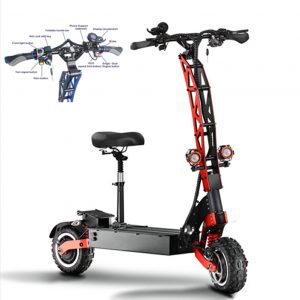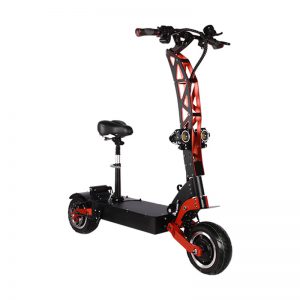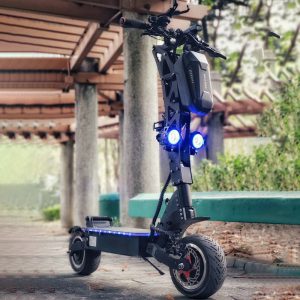Description
electric motor scooter
electric scooter 10000w motorcycle
zero 11 electric scooter
| Parameter | |
| Frame | High strength aluminum alloy 6061, surface paint |
| Forking forks | One forming front fork and rear fork |
| Electric machinery | 11 “72V 10000W brushless toothed high speed motor |
| Controller | 72V 70SAH*2 tube vector sinusoidal brushless controller (mini type) |
| Battery | 72V 40AH-45AH module lithium battery (Tian energy 21700) |
| Meter | LCD speed, temperature, power display and fault display |
| GPS | Location and telecontrol alarm |
| Braking system | After one disc, does not contain harmful substance, in compliance with international environmental requirements |
| Brake handle | Forging brake of aluminum alloy with power breaking function |
| Tyre | ZhengXin tire 11 inch |
| Headlight | LED lenticular bright headlights and driving lights |
| Maximum speed | 110km |
| Extension mileage | 115-120km |
| Motor | 5000watt per piece |
| Wheel | 11inch |
| Net weight and gross weight | 54kg/63kg |
| Product size | L* w* h: 1300*560*1030 (mm) |
| Packaging size | L* w* h: 1330*320*780 (mm) |

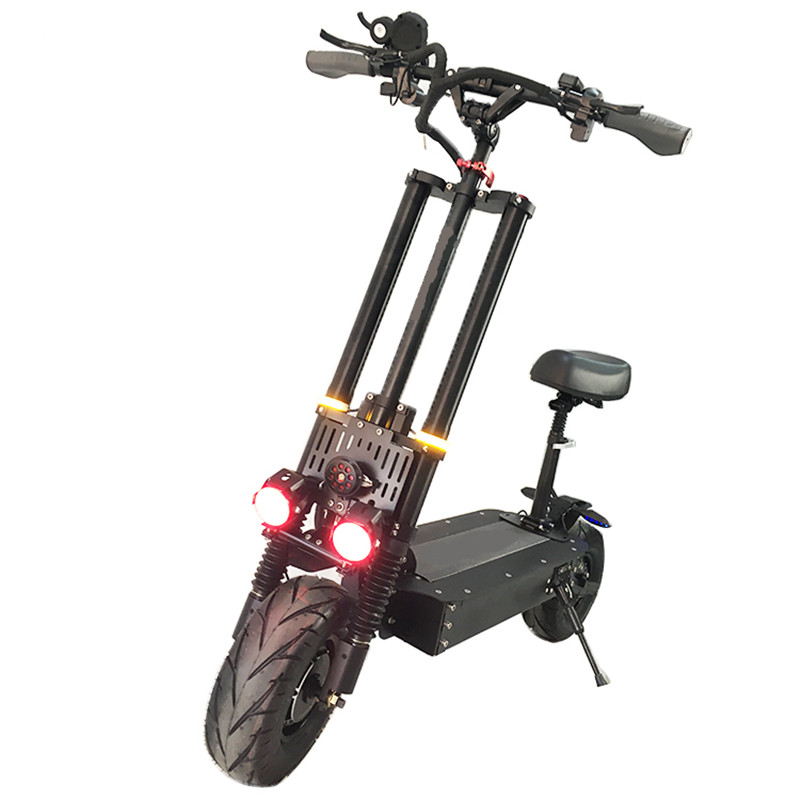
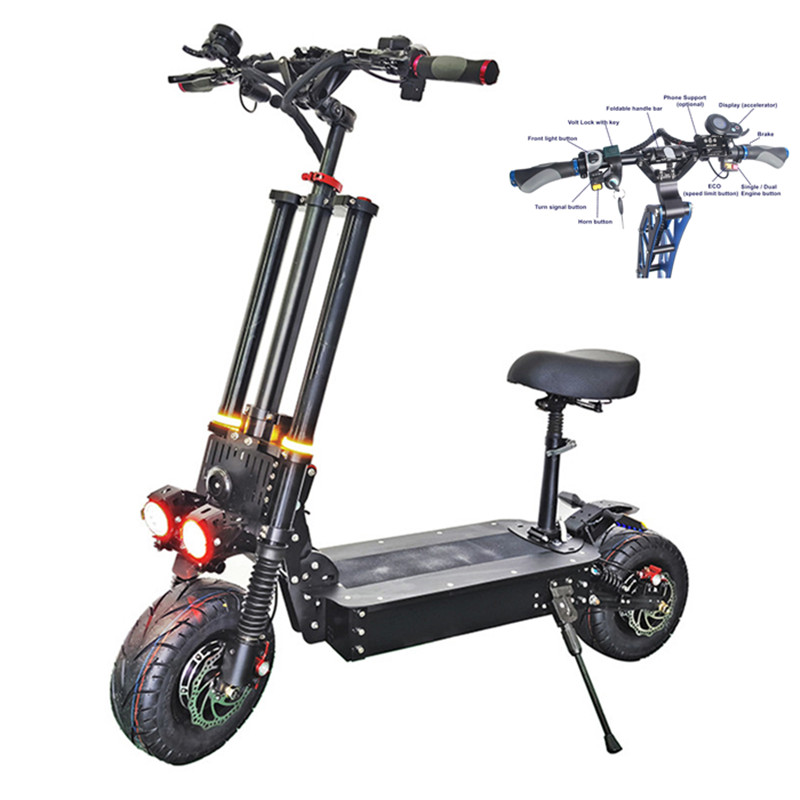
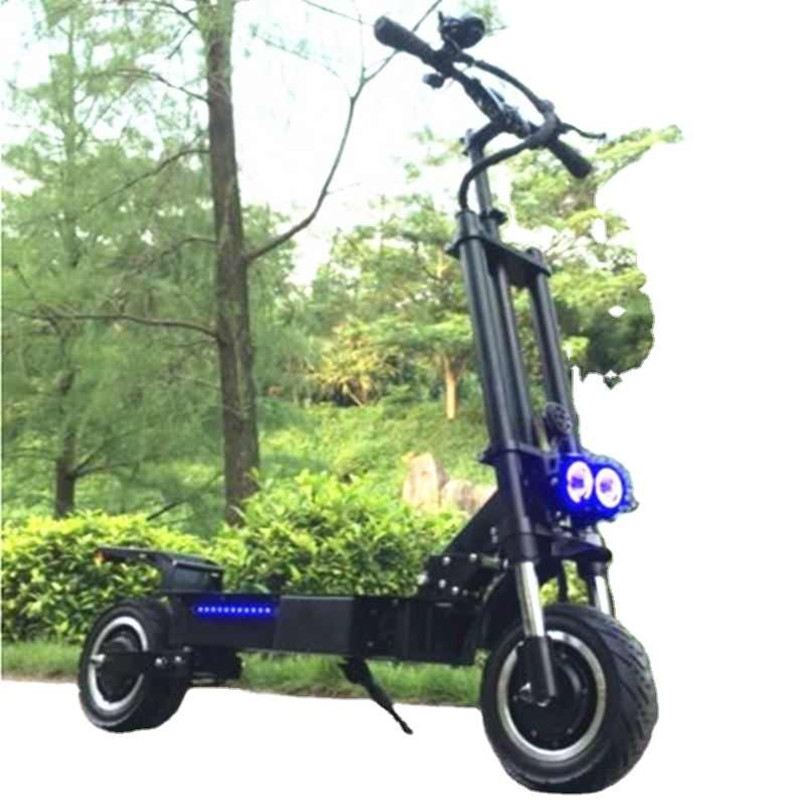
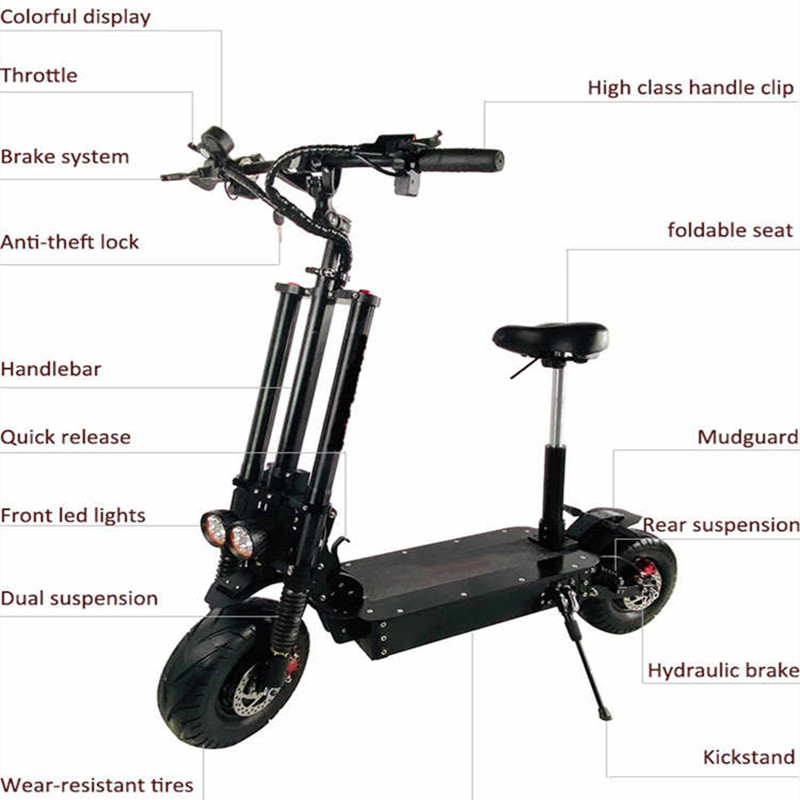
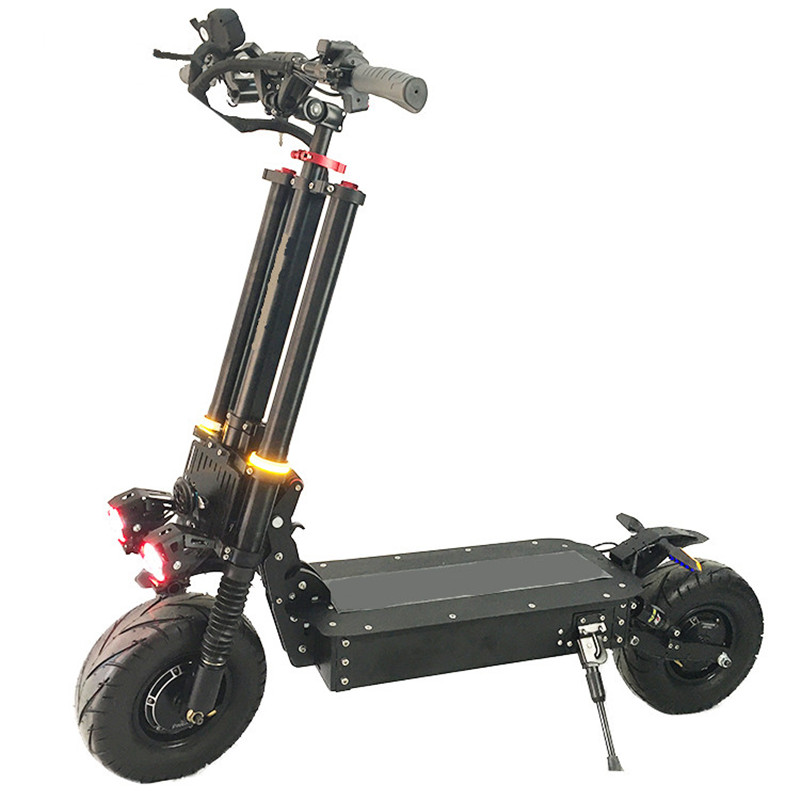
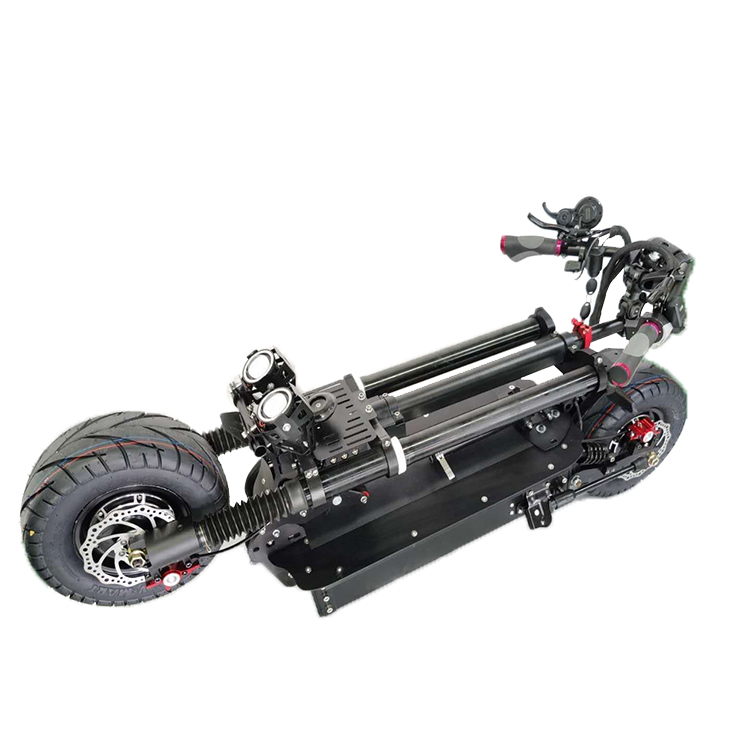
Bigger battery packs have more capacity, measured in watt hours, and will let an electric scooter travel further. More specifically, they are made of 18650 cells, a size classification for lithium ion (Li-Ion) batteries with 18 mm x 65 mm cylindrical dimensions. They also have excellent longevity meaning that they can be discharged and recharged or “cycled” many times and still maintain their storage capacity. Battery cells are operated from 3.0 volts (0% charge) up to 4.2 volts (100% charge). Li-Ion batteries have excellent energy density, the amount of energy stored per their physical weight. E-scooter battery packs are made of many individual battery cells. 3.6 volts (nominal) and having a capacity about 2.6 amp hours (2.6 A·h) or about 9.4 watt-hours (9.4 Wh). However, they also increase the size and weight of the scooter – making it less portable. Additionally, batteries are one of the most expensive components of the scooter and overall cost increases accordingly.
In this technical guide, you’ll learn everything there is to know about 13 inch electric scooter batteries, including types, capacity ratings, how to prolong battery life, and proper use and storage. By Justin. Justin has a degree in engineering and is a cofounder of ESG. In a scooter, the battery pack is made of individual cells and electronics called a battery management system which keeps it operating safely. The battery is your electric scooter’s “fuel tank.” It stores the energy that is consumed by the DC motor, lights, controller, and other accessories. He has helped develop the technologies behind the ESG website and authors articles covering the science and technology around the technical aspects of electric scooters. See our in-depth guide on how to charge an electric scooter for best practices to prolong battery life. Many electric scooters for kids and other inexpensive models contain lead-acid batteries. Most electric scooters will have some type of lithium ion-based battery pack due to their excellent energy density and longevity.
Though Li-ion 18650 cells have amazing benefits, they are less forgiving than other battery technologies and can explode if used improperly. The BMS should prevent overcharging. The battery management system (BMS) is an electronic component that monitors the battery pack and controls charging and discharging. Li-ion batteries are designed to operate between about 2.5 to 4.0 V. Overcharging or completely discharging can shorten battery life or trigger dangerous thermal runaway conditions. Many BMS also cut power before the battery is fully discharged in order to prolong life. Despite this, many riders still baby their batteries by never fully discharging them and also use special chargers to finely control charging speed and amount. More sophisticated battery management systems will also monitor the temperature of the pack and trigger a cutoff if overheating occurs. It is for this reason that they are nearly always assembled into battery packs that have a battery management system.
Once the load is removed the battery voltage will return to its true level. Voltage sag also occurs during long discharge of the battery (such as during a long ride). If the battery is allowed to rest, it will return to its true and accurate voltage level. This unit is quite easy to understand. An average scooter will have a capacity of around 250 Wh and be able to travel about 10 miles at an average of 15 miles per hour. This can result in the battery voltage dropping even more rapidly during the tail end of long ride. E-scooter battery capacity is rated in units of watt hours (abbreviated Wh), a measure of energy. The lithium chemistry in the battery takes some time to catch up with the discharge rate. For example, a battery with a 1 Wh rating stores sufficient energy to supply one watt of power for one hour. More energy capacity means higher battery watt hours which translates to longer electric scooter range, for a given motor size.
Don’t store your scooter fully charged or with the charger plugged in for prolonged periods. We hear from all kinds of people about their broken electric scooters and it’s rarely a battery problem! The main takeaway here is don’t abuse the battery and it will last the useful life of the scooter. Don’t operate the scooter battery in temperatures below 32 F° or above 113 F°. Learn more about how to charge an electric scooter. Charging at a C-rate between below 1 is optimal. Don’t store the electric scooter fully discharged. Li-ion batteries degrade when they drop below 2.5 V. Most manufacturers recommend to store scooters with a 50% charged, and top them up to this level periodically for very long-term storage. Charge your scooter at a lower C-rate, meaning charge the battery at a lower rate relative to its maximum capacity to preserve/improve battery life. Some of the fancier or high speed chargers let you control this.
In comparison, Li-ion batteries have about 10X the energy density compared to lead-acid batteries. The brick-like battery pack is monitored and regulated by an electronic circuit called a battery management system (BMS), which controls the flow of electricity into and out of the battery. These individual strands (many batteries in series) are then connected in parallel to increase output current. Individual cells in the battery pack are connected in series (end to end) which sums their voltage. To build a battery pack with hundreds or thousands of watt hours of capacity, many individual 18650 Li-ion cells are assembled together into a brick-like structure. By adjusting the number of cells in series and parallel, electric scooter manufacturers can increase output voltage or max current and amp hour capacity. Changing the battery configuration will not increase total energy stored, but it effectively allows a battery to offer more range and lower voltage and vice versa. This is how its possible to have scooters with 36 V, 48 V, 52 V, 60 V, or even larger battery packs.
How long do electric scooter batteries last? When storing for very long periods of time, make sure to charge them periodically so they are not being stored completely discharged. How can you maximize electric scooter battery life? The highest-quality, brand name cells may last upwards of 1000 charging cycles, if babied. Learn more about how to maximizing battery life. Yes! you can replace the battery in your electric scooter, though it may not be cost effective. Batteries are one of the most costly components of the electric scooter. Even a small 250 watt hour battery, like that from an M365, costs around $150 US or about ⅓ the cost of the entire scooter! Electric scooters can go through between 300 to 500 charging cycles before starting to lose battery capacity. It’s not that difficult if you are mechanically inclined, but the novice may find it difficult. Electric scooter batteries will last between 2 to 4 years and between 3000 to 5000 miles depending on storage, use conditions, and battery capacity. Is it worth the cost? How many times can you charge an electric scooter battery? You can prolong battery life by storing the scooter charged to 50%, charging it with a C-rate below 1, and not operating the scooter when it is too cold (below 32 F°) or too hot (above 114 F°). For common scooters like the M365, there are many video tutorials online of the replacement procedure. Can you replace electric scooter batteries? If you use your scooter more or store it improperly, the battery life will be shorter. When storing for prolonged periods of time, make sure to top the batteries periodically.
If you’re doing research on battery charging, you’re likely to encounter C-rate. Keep in mind that “diminish in capacity” doesn’t mean “lose all capacity,” but means a noticeable drop of 10 to 20% that will continue to get worse. Modern battery management systems help to prolong the life of the battery and you shouldn’t worry too much about babying it. For an average electric scooter, this is 3000 to 10 000 miles! C-rate describes how quickly the battery is being fully charged or discharged. For example, a C-rate of 1C means the battery is charged in one hour, 2C would mean fully charged in 0.5 hours, and 0.5C would mean fully charged in two hours. However, if you’re keen on stretching the battery life as much as possible, there are some things you can do to exceed 500 cycles. A typical Li-ion battery will be able to handle 300 to 500 charge/discharge cycles before diminishing in capacity. If you fully charged a 100 A·
Li-ion actually refers to many battery chemistries that involve the lithium ion. This battery gives high capacity and output current. Lead-acid batteries have the benefit of being inexpensive, but suffer from having very poor energy density, meaning that they weigh a lot compared to the amount of energy they store. Consequently, this reduces the chances of thermal runaway and fire. They are also found in some electric scooters; most notably, inexpensive children’s scooters from companies like Razor. Fortunately, many quality electric scooters are using the INR battery chemistry – one of the safest chemistries. Each of these battery chemistries represents a trade-off between safety, longevity, capacity, and current output. Lead-acid is a very old battery chemistry that is commonly found in cars and some larger electric vehicles, like golf carts. Some electric scooters with INR chemistry include WePed GT 50e and Dualtron models. The presence of manganese lowers the internal resistance of the battery, allowing high current output while maintaining low temperatures.
Extreme performance scooters can have a capacity reaching into the thousands of watt hours and ranges of up to 60 miles. If that is not within your budget, then make sure you are buying a scooter from a reputable manufacturer who is using quality parts and has good quality control (QC) measures in place. Individual Li-ion cells in an e-scooter battery pack are made by just a handful of different internationally-known companies. The highest quality cells are made by LG, Samsung, Panasonic, and Sanyo. Some examples of companies that are likely to have good QC are Xiaomi and Segway. These types of cells tend to be found only in battery packs of higher-end scooters. The difference between scooters with branded cells and generic Chinese ones is a greater guarantee of quality control with established brands. Most budget and commuter 13 inch electric scooters have battery packs made from generic Chinese-manufactured cells, which vary greatly in quality.

